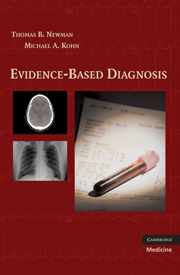Book contents
- Frontmatter
- Contents
- Preface
- Acknowledgments & Dedication
- Abbreviations/Acronyms
- 1 Introduction: understanding diagnosis and diagnostic testing
- 2 Reliability and measurement error
- 3 Dichotomous tests
- 4 Multilevel and continuous tests
- 5 Critical appraisal of studies of diagnostic tests
- 6 Screening tests
- 7 Prognostic tests and studies
- 8 Multiple tests and multivariable decision rules
- 9 Quantifying treatment effects using randomized trials
- 10 Alternatives to randomized trials for estimating treatment effects
- 11 Understanding P-values and confidence intervals
- 12 Challenges for evidence-based diagnosis
- Answers to problems
- Index
- References
6 - Screening tests
Published online by Cambridge University Press: 04 August 2010
- Frontmatter
- Contents
- Preface
- Acknowledgments & Dedication
- Abbreviations/Acronyms
- 1 Introduction: understanding diagnosis and diagnostic testing
- 2 Reliability and measurement error
- 3 Dichotomous tests
- 4 Multilevel and continuous tests
- 5 Critical appraisal of studies of diagnostic tests
- 6 Screening tests
- 7 Prognostic tests and studies
- 8 Multiple tests and multivariable decision rules
- 9 Quantifying treatment effects using randomized trials
- 10 Alternatives to randomized trials for estimating treatment effects
- 11 Understanding P-values and confidence intervals
- 12 Challenges for evidence-based diagnosis
- Answers to problems
- Index
- References
Summary
Introduction
You may wonder why we have a separate chapter on screening tests. After all, now that you have learned about sensitivity, specificity, likelihood ratios, Receiver Operating Characteristic curves and so forth, it seems like you should be well equipped to evaluate screening tests. However, whereas diagnostic tests are done on sick people to determine the cause of their symptoms, screening tests are generally done on healthy people with a low prior probability of disease. The problem of false positives and possible harms of unnecessary treatment looms larger. The questions of whether the patient benefits from being diagnosed and whether this benefit justifies the possible harms and costs of the test are more salient for screening. Finally, because decisions about screening are often made at the population level, political and other factors may be more influential. Thus, in this chapter, we focus explicitly on the question of whether doing the test improves health, not just whether it gives the right answer, and we pay particular attention to biases and nonmedical factors that can lead to excessive screening.
Definition and types of screening
Our favorite definition of screening is that suggested by Eddy (1991): “the application of a test to detect a potential disease or condition in people with no known signs or symptoms of that disease or condition.” The “test” being applied may be a laboratory test or x-ray, or it may be nothing more than a standard series of questions, as long as the goal is to detect a disease or condition of which the patient has no known symptoms.
- Type
- Chapter
- Information
- Evidence-Based Diagnosis , pp. 116 - 137Publisher: Cambridge University PressPrint publication year: 2009
References
- 2
- Cited by



